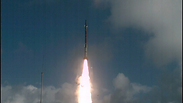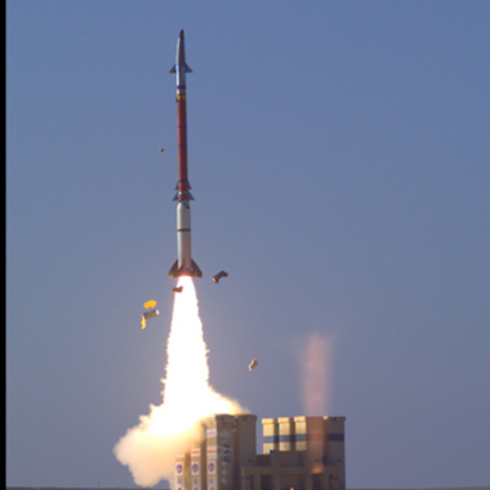
David's Sling passes final round of tests
Air defense system, capable of intercepting medium-range missiles, low-flying aircraft or cruise missiles, is now on course for deployment within the next four months.
David's Sling is designed to shoot down rockets with ranges of 100 to 200 km (63 to 125 miles), aircraft, or low-flying cruise missiles. It will fill the operational gap between the Iron Dome short-range rocket interceptor and the Arrow ballistic missile interceptor, both already in service.
The three systems incorporate a network of radar-guided interceptors designed to shoot down everything from the low-flying, Katyusha-style rockets of Hezbollah and Palestinian guerrillas to the ballistic Shehab and Scud missiles of Iran and Syria.
The final test of the air defense system was conducted on Monday morning in a test field in southern Israel ahead of its delivery to the Air Force in the next four months. The system is scheduled to become operational in the coming year.
The IDF will deploy four David's Sling batteries, with the Air Force receiving two in the first stage. The batteries could either operate from one permanent location, similar to the Arrow air defense system, or be mobile, allowing the military to deploy it wherever needed, similar to the Iron Dome air defense system.
David's Sling can either operate independently of the other air defense systems, based on Israel's security needs and the threats it faces, while intercepting several projectiles at the same time, or work alongside the Arrow and Iron Dome systems.
The Defense Ministry did not detail the amount of target missiles that were intercepted in the tests, nor their type, but noted that in general, the system is capable of identifying and intercepting target missiles with a warhead that could reach hundreds of kilograms of explosives.
The tests included all of the system's components, including its interceptor launchers and its radars, that have already gone operational during Operation Protective Edge, assisting in the operations of Iron Dome.
"This series of tests completes the first chapter in development and will allow us to bring the system to the Air Force soon," said a senior official in the Defense Ministry's weapons development department.
Shlomo S, the head of the project from Israeli defense firm Rafael, said: "We're excited this morning after the completion of the series of tests, during which we developed technologies that are first of their kind in the world and have so far been considered science fiction. Representatives from the Air Force's David's Sling unit participated in the experiment, to allow them to take over the system later on. This feels like a dream come true, as the goals and targets we had were achieved in full, and that is a rare thing in the development of systems of this kind."
David's Sling is being developed and manufactured jointly by Israel's state-owned Rafael Advanced Defense Systems Ltd and Raytheon Co, a top US arms maker.
Rafael also makes Iron Dome, which has been extensively bankrolled by the US Congress. Israel and the United States say Iron Dome batteries have proven capable of shooting down around 90 percent of Palestinian rockets fired from Gaza.
Like Iron Dome and Arrow, David's Sling has drawn interest from prospective foreign clients, especially as it is also billed as being capable of intercepting cruise missiles.
But the system lost out on a Polish tender in 2014, and its development schedule took further hits from budget shortfalls and the Gaza war that year. During that seven-week conflict, officials said some David's Sling radars were dismantled and adapted for use on makeshift new Iron Dome batteries.
On Dec. 10, Israel and the United States said they held a successful interception test for the upgraded Arrow 3, which hit a target in space.
Reuters contributed to this report.












